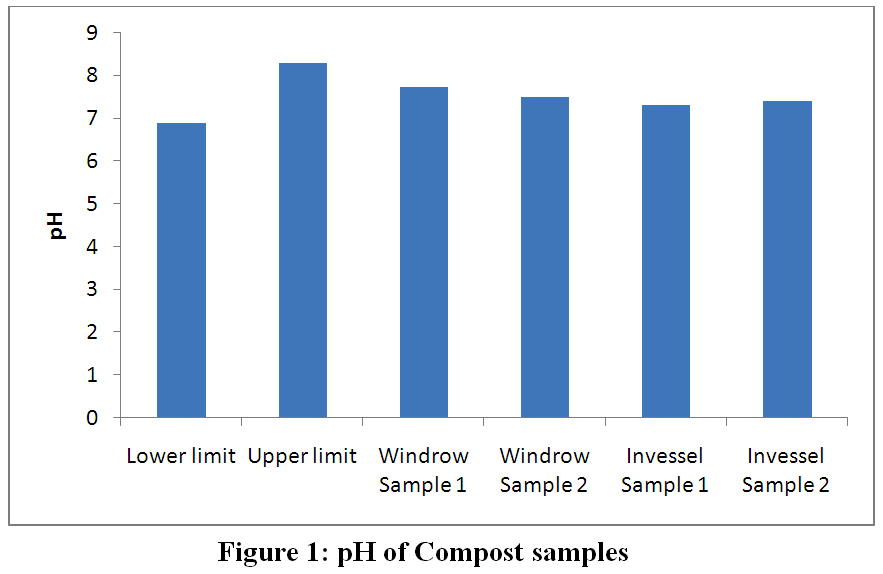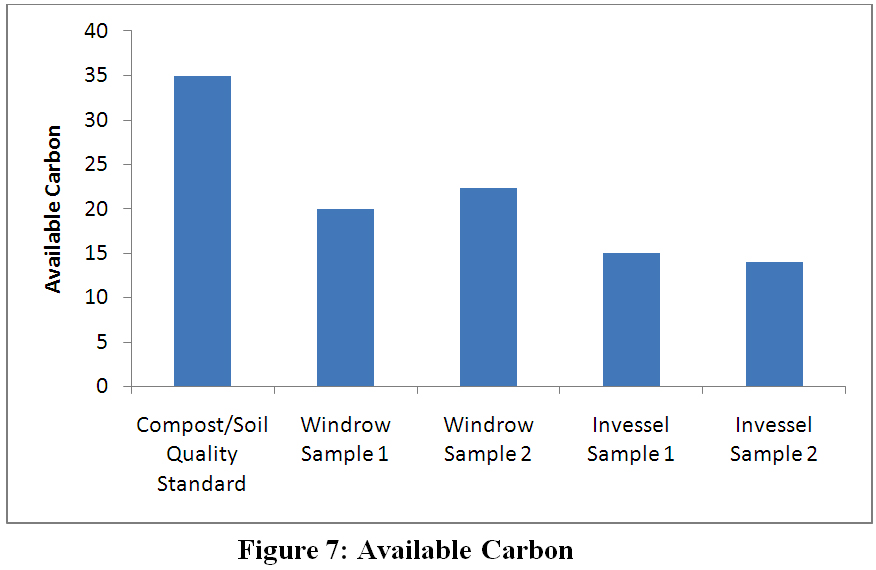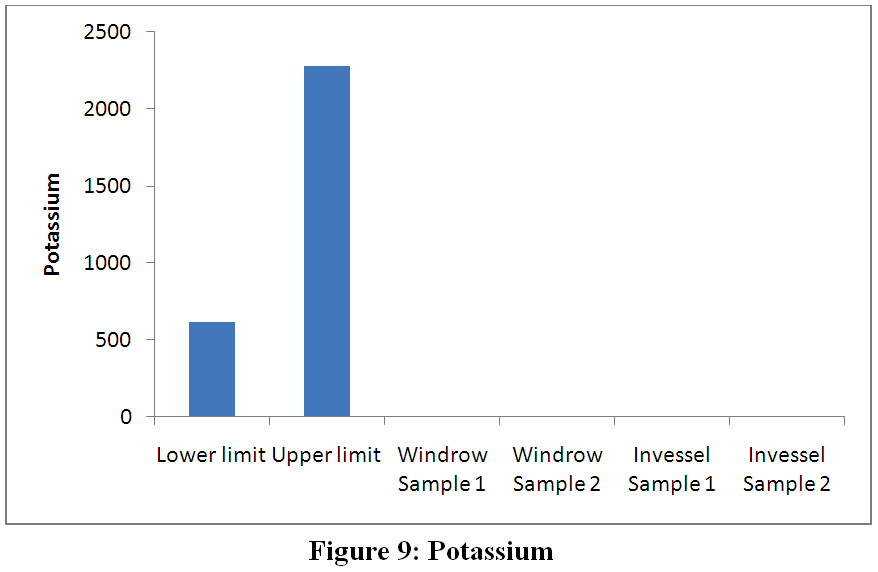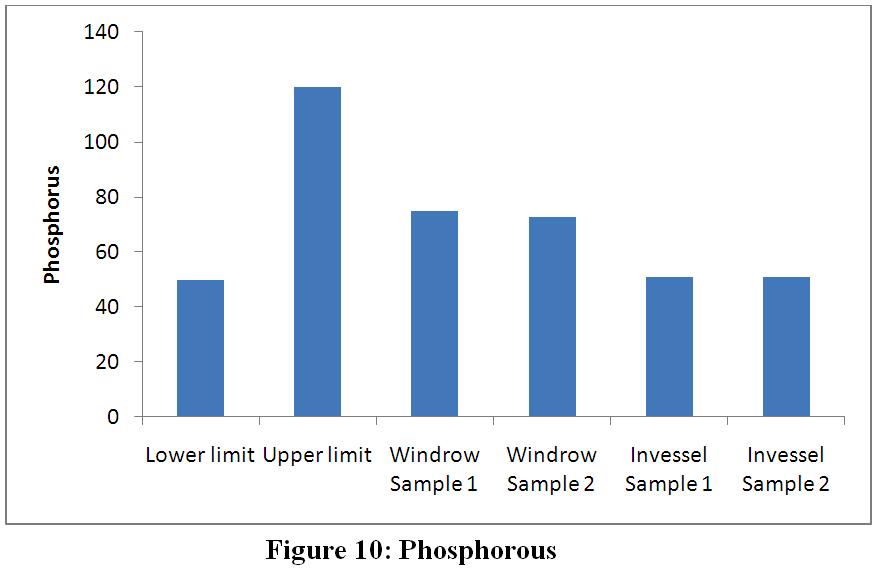Comparative Evaluation of Chemical Composition of Commercially Available Windrow Compost Sample and Privately Prepared In-Vessel Compost Samples
Syeda Amber Fatima1 * , Mohammad Nawaz Chaudhary2 and Syeda Adila Batool3
Corresponding author Email: amber.fatima1985@gmail.com
DOI: http://dx.doi.org/10.12944/CWE.14.1.14
In developing countries like Pakistan the organic waste production is comparatively high. Composting is a good option to overcome problems related to management of organic waste. Compost produced from solid waste should be according to the standards set for soil to ensure beneficial results in plants. The objectives of the study were to determine the quality of compost used in agricultural lands in different areas of country.In the study area the commercially available compost is prepared by windrow composting method. Some home gardeners prepare compost by invessel method. But the sale of commercial compost decreased with the passage of time. One of the reasons behind this includes low quality compost and less desired results in terms of soil fertility. Comparative analysis of windrow compost sample and in-vessel compost samples were carried out to identify the fate of these composts in terms of international standards. Analysis results revealed that some parameters were lower than standard values i.e. moisture content was less than 45% in all samples, carbon nitrogen (C:N) ratio was less than 25 which should be >25, available carbon was < 35% in all samples and burned carbon was also <35% in all samples. Compost is used as a soil conditioner and low level fertilizer however if its nutritional value is not according to the standard it maybe no longer beneficial for plants. Substandard compost can also cause microbial degradation in soil and can make it anaerobic as well.
Copy the following to cite this article:
Fatima S. A, Chaudhary M. N, Batool S. A. Comparative Evaluation of Chemical Composition of Commercially Available Windrow Compost Sample and Privately prepared In-vessel Compost samples. Curr World Environ 2019;14(1). DOI:http://dx.doi.org/10.12944/CWE.14.1.14
Copy the following to cite this URL:
Fatima S. A, Chaudhary M. N, Batool S. A. Comparative Evaluation of Chemical Composition of Commercially Available Windrow Compost Sample and Privately prepared In-vessel Compost samples. Curr World Environ 2019;14(1). Available from: https://bit.ly/2Zq7gsZ
Download article (pdf)
Citation Manager
Publish History
Select type of program for download
| Endnote EndNote format (Mac & Win) | |
| Reference Manager Ris format (Win only) | |
| Procite Ris format (Win only) | |
| Medlars Format | |
| RefWorks Format RefWorks format (Mac & Win) | |
| BibTex Format BibTex format (Mac & Win) |
Article Publishing History
| Received: | 2019-01-30 |
|---|---|
| Accepted: | 2019-04-10 |
| Reviewed by: | 
 Dr. Nur Hidayati
Dr. Nur Hidayati
|
| Second Review by: |

 Rishikesh Singh
Rishikesh Singh
|
| Final Approval by: | Dr. Gopal Krishan |
Introduction
In agrarian countries like Pakistan, the amount of organic waste in solid waste is up to 75%. Most of the organic waste is dumped into dumping site without any segregation.1 Considering the lower economic status of Pakistan’s farming community, high capital investment often leads to lower quantity application. These are the reasons why the application of organic soil inputs even over a period of years has not been able to regenerate healthy soil to attain sustainable production. In the present agricultural scenario compost is the best option available to restore and enhance soil potential in order to attain sustainable soil and crop productivity.2 Composting is the biological degradation of organic material in the presence of oxygen, carbon dioxide and water which results in a humus-like end product that serves as a natural, sustainable, safe and economical method of waste management.3
In the study area, people used to make compost in home gardens by an in-vessel method and use it in their own gardens. This type of composting is done in a controlled environment normally in a drum or bucket or any container. While the organic waste of the city is utilized in two different compost plants in which the windrow method of composting is done. In windrow composting the organic waste, piles are made in rows. It is an aerobic type of composting, aeration of piles is done by turning piles frequently. The final product of this process is stable and enriched humus containing compost consisting of sufficient amount of nutrients required by soil like nitrogen, phosphorus, potassium, calcium and magnesium.4 It was observed that the sale of commercially prepared compost has been decreased for last few years. Farmers prefer synthetic fertilizers instead of compost. One of the reasons behind this may be that the quality of the composts is not up to the mark. And the farmers did not get desired productivity. This study aims to find out the quality of compost available in the market.
Windrow composting being aerobic and cost-effective is the most used method to amend soil conditions. Several beneficial effects of compost on soil are being reported by different authors.5,6 Composting is the best solution to less land availability, eutrophication and climate change.7 Composting is also an option to recycle industrial organic by-products to be used as soil conditioner.8
Besides the benefit mentioned above the composting can also prevent eutrophication as chemical fertilizers contain excessive nutrient (N, P, K) that drains into water bodies and enhance eutrophication.9 But in the study area, the commercial compost is not sold out on a large scale and the reason is an unawareness of the farmers and as well as less beneficial results after using compost.
For sustainable agriculture, the nutrients of plants are very important.10 Chemical fertilizers may increase the fertility of the soil but they cause severe environmental pollution. However composting being a biological process can fulfil these needs.11 But maturity and stability of compost is an important factor in the successful use of it, as immature or unstable compost can induce anaerobic condition in the soil.11 Immature compost also causes phytotoxicity due to the presence of acids.12
Methodology
Sampling
To find out the difference in composition and quality of composts four composting sites were selected and two commercial composting sites where windrow composting is done and two privately produced compost from the house by the in-vessel composting method. From the commercial site, random samples were taken in packed form and then they were mixed by conning and quartering method. Hence two representative samples from each composting plants were obtained.
And two houses were selected for compost sampling where the proper method of the in-vessel method was followed. Two samples were taken from these two houses.
Sample Analysis
Samples were analyzed to check the compost quality and the detailed analysis are given below.
pH: 5 gm of compost sample was mixed in 10ml of water in a beaker and pH meter was used to check the pH of the sample by dipping the probe into the sample solution.13
Moisture Content: 5 grams of sample was taken in a pre-weighed crucible and kept it in an oven at 105°C for 24 hours. After drying weighed again and the percentage difference of weight was calculated as dry weight of the sample was lesser than wet weight and per cent moisture content was calculated.14
Carbon, Nitrogen Ratio: Kjeldahl Method was used for the determination of total nitrogen, and loss on ignition method was used for the determination of carbon.15
Nutrients: (P, K): Flame photometer was used for the determination of potassium and phosphorus was determined by Olsen’s method.16
Available and Burned Carbon: LECOcarbon-nitrogen (CN2000) analyzer was used to determine availability and burned carbon in sample.17
Salinity: Salinity actually amounts of water-soluble salts in a substance. For compost, salinity was determined by Refractometer normally used for determination of soil salinity.18
Sodicity: Sodicity is the amount of sodium present in substance usually termed as exchangeable sodium percentage (ESP). Sodicity was determined by making a solution of compost and 10gm soil in 10ml of water. pH of the solution reflects the amount of sodium present in it. High pH means high sodium content then sodium were analyzed by flame photometer.19, 20
Pathogen: Pathogen or microbial detection in compost samples was done by a simple cultural method. Microbial culture in compost sample was allowed to grow in media and visual confirmation of growth was done.
Results and Discussion
According to compost and soil quality standards, pH of compost should be in between 6.9 to 8.3. It was found that all samples had pH within the range (Fig 1). The more the pH exceeds 7.5, there will be more chances of gaseous loss of ammonia.21
 |
Figure 1: pH of Compost samples Click here to view Figure |
The moisture content of compost should be 45 – 65% but the samples had very low moisture contents; as show in figure 2 below. Windrow sample 1 had a moisture content of 11.37%, windrow sample 2 had 17.58%, in-vessel sample 1 had 20.7% and in-vessel sample 2 had 18.5% of moisture content.
 |
Figure 2: Moisture Content Click here to view Figure |
According to compost quality standards, the bulk density should be 0.42 to 0.65gm/cm3. Bulk densities of all the samples were within the range i.e. windrow sample 1 had 0.45, in-vessel sample 2 had 0.4, and in-vessel sample 2 had 0.42 except one windrow sample 1 which bulk density had slightly higher i.e 0.67 than a standard limit (Fig 3). High bulk density leads to problems in root growth. Roots may remain shallow due to fewer pore spaces. One study on Maize crop has proved that high bulk density resulted in a reduction of root and shoot biomass.22
 |
Figure 3 Bulk density Click here to view Figure |
It was found that in privately produced composts the salinity was higher than standard. This compost may increase the salinity of soil resulting in damage to the plant. More saline compost can cause salinity in the soil. The commercially produced compost in the study area had salinity 2.89 and 2.69DS/m which was within the permissible limit i.e.4DS/m. while in home compost sample the salinity was very high i.e. 8.99 and 7.6 DS/m as shown in fig 4 below. The reason for high salinity in the in-vessel sample may be the mishandling of equipment used and improper segregation of organic waste. A study on the effect of salinity revealed that high salinity not only affect the root or shoot growth but it can inhibit the growth of the seed. A high saline soil cannot be cultivated as it can kill seed.23
 |
Figure 4: Salinity in samples Click here to view Figure |
The supply of carbon relative to nitrogen (C: N ratio) determines whether net mineralization or immobilization of nitrogen will occur. Mineralization is the conversion of organic nitrogen to mineral forms (like ammonium and nitrate); immobilization is the incorporation of nitrogen into microbial biomass. If the C: N ratio is greater than 20:1, microbes will immobilize nitrogen into their biomass.24 A good compost must have 1 part nitrogen and 25 parts carbon but the samples had very low C: N ratio. All of the samples in the study area had low carbon content than required for a good compost i.e. 17:1 in Windrow sample 1 and 18:1 in Windrow sample 2, 12.1:1 in vessel sample 1 while in vessel sample 2, it was 14.1:1 (Fig 5).
 |
Figure 5: C: N Ratio Click here to view Figure |
Sodicity is a term given to the amount of sodium held in a compost. Sodium is one of many types of cations that are bound to clay particles. A Sodic Compost has too much Sodium associated with the negatively charged clay particles. Other cations bound to clay particles include Calcium, Magnesium, Potassium and Hydrogen. Sodicity of the sample was found high in all samples as shown in the figure below.
Compost quality standard allows less than 15mg/Kg of sodium but in all samples the sodium content was high. In windrow sample 1 and 2, the Sodicity was 19.2 and 34 respectively and in vessel samples 1 and the Sodicity was 29.6 and 23.4mg/Kg (Fig 6).
 |
Figure 6: Sodicity Click here to view Figure |
Compost has two essential nutrients for its effective use i.e. Nitrogen and Carbon. Normally green waste consists of grass, leaves, vegetables and fruit leftovers that are enriched with nitrogen and phosphorous. Brown waste includes hay, paper, wood, dead plants which contain a high amount of carbon, hydrogen and oxygen. The green waste contains appreciable amounts of nitrogen, phosphorus, and mineral nutrients and has low C/N ratios.25
If there is too much carbon, decomposition slows down as available nitrogen gets used up and the microorganism population drops. So the amount of carbon should be in optimum range otherwise the microbial activity is slowed down.
Both available and burnt carbon should be more than 35% in compost. But in all the samples of windrow compost, there was less available and burnt carbon except in windrow sample 2 the burnt carbon was according to the standard limit. In windrow samples 1 and 2, the available carbon was 20 and 22.4 while burnt carbon was 46 and 25% respectively. While in in-vessel sample 1 and 2 the available carbon was 15 and 14% respectively and the burnt carbon was according to the standards i.e. 41 and 40% respectively. Figures 7 and 8 below depict it.
 |
Figure 7: Available Carbon Click here to view Figure |
 |
Figure 8: Burnt Carbon Click here to view Figure |
Potassium is not incorporated into organic compounds in plants or animals, so K in compost is readily available. It is an essential nutrient for plants but very low potassium content was found in all compost sample. There should be 620 to 2280mg/Kg of potassium in compost but the sample had very low content i.e. 0.6, 0.61, 0.6 and 0.6 mg/Kg in window 1 and 2 and in-vessel 1 and 2 respectively (Fig 9).
 |
Figure 9: Potassium Click here to view Figure |
Phosphorus is also an essential nutrient for plants. If the compost applied does not contain these essential nutrients, it is no more beneficial for the plants. Compost quality standards permit 50 to 120 mg/Kg of phosphorus and in windrow samples 1 and 2 the phosphorus was 75 and 73 mg/Kg respectively while in the in-vessel method the compost had 51 mg/Kg of phosphorus in both samples as shown below in figure 10. Deficiency of phosphorus in plants results in stunt growth, inhibition of flowering26
 |
Figure 10: Phosphorous Click here to view Figure |
There should be 15 to 240 ppm of nitrogen in compost. The samples had normal nitrogen content, windrow sample 1 had 20 ppm sample 2 had 30ppm while in both in-vessel samples the nitrogen was 20ppm (Fig 11). The low nitrogen content in soil affects the plant bloom and foliage. And too much nitrogen can harm the plant.27
 |
Figure 11: Nitrogen Click here to view Figure |
It was found that there were or negligible microbes in all the samples of compost (Fig 12). If the pathogen is present on compost then they can infect plants. Compost may contain salmonella, fungus and other pathogenic organisms if it is produced by contaminated waste from a municipal source.
 |
Figure 12: Microorganisms Click here to view Figure |
Conclusion
From the above results obtained by the chemical and physical analysis of the compost, it can be concluded that the compost available in the market is not up to the mark. The commercially produced compost does not meet the standards (Compost Quality standards) that is why the farmers who previously bought the compost are no more willing to buy it due to unsatisfactory results. So the hypothesis of the study that compost produced in the study area does not give required yield in, crops, can say to be proved correct.
Acknowledgements
I would like to express my sincere thanks and gratitude to Principal College of Earth and Environmental Sciences Prof. Dr Sajid for his providing all the facilities in the department to carry out research.
And I would express my deepest gratitude to my research supervisor, Prof. Dr Muhammad Nawaz Chaudhry and Co-Supervisor Dr Adila Batool for their guidance and encouragement. Without their constant support, I would not have been able to complete my research work.
Funding Source: None
References
-
Haydar, Masood J. Evaluation of kitchen waste composting and its comparison with compost prepared from municipal solid waste. Pak. J. Eng. & Appl. Sci.2011; 26-33.
-
Chatterjee N., Flury M., Hinman, Cogger C G. Chemical and physical characteristics of compost leachate.2013: August 23.
-
Herity L. A. Study of the quality of waste derived in Ireland. Pan American Health Organization. Retrieved on 15th July International:[about 4 screens]. Available from: www.bvsde.paho.org. 2015.
-
Ogunwande G.A., Osunade J. A., Adekalu K. A., Ogunjimi L. A. O. Nitrogen loss in chicken litter compost as affected by carbon to nitrogen ratio and turning frequency. Bio. Res Tech.2008; 99 (16):7495-7503.
CrossRef -
Aggelides S. M. and Londra P. A., “Effects of Compost Produced from Town Wastes and Sewage Sludge on the Physical Properties of a Loamy and a Clay Soil,” Biore-source Technology, Vol. 71, No. 3, pp. 253-259 doi:10.1016/S0960-8524(99)00074-7, 2000
CrossRef -
Soumaré M., Demeyer A., Tack F. M. G., and Verloo M. G., “Chemical Characteristics of Malian and Belgian Solid Waste Composts,” Bioresource Technology, 2002; Vol. 81, No. 2, pp. 91-101. doi:10.1016/S0960-8524(01)00125-0.
CrossRef -
Mazumdar N. B., “Composting Municipal Solid Waste: The Indian scenario,” International Journal of Environment Technology and Management, 2007; (7): 326-350.
CrossRef -
USEPA, “Wastes-Resource Conservation-Common Wastes and Materials-Organic Materials,” 2012.
-
Favoino E. The potential of composting in reducing greenhouse gases. Waste mng and Res.2008 February; 26(1):61-69.
CrossRef -
He X.T., Logan T.J., Traine S.J. Physical and chemical characteristics of selected U.S. municipal solid waste composts. J Environ Qual 1995; (24):543–552.
CrossRef -
Butler T.A., Sikora L.J., Steinhilber P.M., Douglass LW Compost age and sample storage effects on maturity indicators of biosolids compost. J Environ Qual 2001; (30):2141–2148.
CrossRef -
Mathur S.P., Owen G., Dinel H., Schnitzer M Determination of compost biomaturity. I. Literature review. Biol Agric Hortic1993; (10):87–108.
CrossRef -
Ryckeboer, J., Mergaert, J., Coosemans, J., Deprins, K., and Swings, J. Microbiological aspects of biowaste during composting in a monitored compost bin. Journal of Applied Microbiology, 2003; 94(1): 127-137.
CrossRef -
United States Environmental Protection Agency, EPA Method for determination of pH of the soil. EPA9045D.
-
American society of testing and methods, ASTM D2216-10 Method for determination of Moisture content of the soil.
-
American society of testing and methods, ASTM 5310: P05001A Method for determination of Carbon, Nitrogen ratio.
-
American society of testing and methods, ASTM05001A Method for determination of Nutrients in the soil.
-
American society of testing and methods, ASTM 5310, a method for determination of Available and Burnt carbon
-
American society of testing and methods, ASTM D4542, Method for determination of Salinity
-
American society of testing and methods, ASTMD3875-08, Method for determination of Sodicity
-
American society of testing and methods, ASTM D6734, a method for determination of Pathogen in compost.
-
Cooperband L R. Composting: Art and science of organic waste conversion to a valuable soil resource. June 31, 2000; (6).
CrossRef -
Ying Yong Sheng Tai Xue Bao, Effect of soil bulk density on maize growth under different water regimes, PubMed, 2003 Nov 14;(11):1906-10.
-
Flowers T. S., Yeo A. R. Effects of Salinity on Plant Growth and Crop Yields, Environmental Stress in Plants pp 101-119.
CrossRef -
Michel Jr, F. C., Pecchia J. A., Rigot J., and Keener H. M. Mass and nutrient losses during composting of dairy manure with sawdust versus straw amendment. Compost Science and Utilization, 2003; 23: 1-33.
-
Levitan D. The global progress of composting food waste. Economic Cooperation Organization.[Internet]. August 19[2015 August 19]; International:[about 2 screens].Available from:www.ecowatch.com, 2015
-
https://www.smart-fertilizer.com/articles/phosphorusretrieved on 23rd March 2019).
-
https://homeguides.sfgate.com/effects-much-nitrogen-plants-43755.html retrieved on 23rd March 2019)






